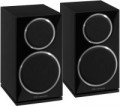Sensitivity
Speaker sensitivity.
This characteristic is indicated on the basis of how loud the acoustics are capable of producing when a signal of a certain standard power is applied to it. Simply put, the higher the sensitivity of the speaker, the louder it will sound at the same output power of the amplifier. Thus, sensitive acoustics can be effectively used even in combination with relatively low-power "amplifiers". On the other hand, low sensitivity also has its advantages: it allows you to achieve a more uniform frequency response and reduces the likelihood of overloading the amplifier. In the least sensitive modern speakers, this indicator
does not exceed 84 dB, in the most sensitive it is
95 – 96 dB or
more.
Note that in fact, you have to pay attention to this parameter when acoustics are planned to be used with a separately selected power amplifier. Therefore, for active systems (see "Type"), sensitivity is purely a reference value, and, usually, it can be ignored when choosing.
Crossover frequency
The crossover frequency provided in the speaker design.
A crossover is installed exclusively in a multi-band model (see "Number of Bands"). This is an electronic filter that ensures the division of the incoming audio signal into separate frequency ranges and directs each range to "its" set of speakers. And the crossover frequency shows where the boundary between these ranges lies. If there are more than two bands, there will be several such boundaries: for example, for a four-band system it may be specified "0.15 / 0.8 / 2.8 kHz" or "0.12 / 1 / 3.8".
In most cases, this parameter has mainly a reference value: the frequencies of the built-in crossover are selected to match the operating characteristics of the speakers installed in the speaker system.
Maximum amplifier power
The highest power rating of an amplifier that the loudspeakers can handle safely. Too much input power can damage the speakers, so when connecting, make sure that the amplifier's characteristics do not exceed the capabilities of the speakers. It is worth noting that this parameter may be slightly higher than the total nominal power of the acoustics (see below), since in this case we are only talking about the safety of the equipment, and not about the absence of distortion in the sound.
Overall frequency range
The total frequency range that the speaker is capable of reproducing. Specified from the bottom of the range in the lowest frequency component to the top of the range in the highest frequency: for example, in a 2.1 system with main speakers at 100 – 22000 Hz and a subwoofer at 20 – 150 Hz, the total value will be 20 – 22000 Hz.
The wider the frequency range — the fuller the reproduced sound, the lower the likelihood that some part of the low or high frequencies will be "cut off". It is worth noting here that the human ear perceives frequencies on average from 16 Hz to 22 kHz, and from a practical point of view, it makes no sense to provide a wider frequency range in speakers. However, quite a few models go beyond this range, sometimes quite significantly (for example, there are speakers with a range of about 10 – 50,000 Hz). Such characteristics are a kind of "side effect" of high-end acoustics, and they are usually given for advertising purposes.
Thus, the lower limit of the range in modern speakers can be within frequencies
up to 20 Hz, however, higher values \u200b\u200bare more common —
30 – 40 Hz,
40 – 50 Hz, or even
more than 70 Hz. In turn, the upper limit in most modern speakers lies in the range
19 – 22 kHz, although there are deviations both upwards (see above) and
downwards.
Woofer size (LF/MF)
The diameter of the woofer or combined woofer/midrange speaker(s). The larger the speaker, the lower its operating frequencies and the more sound power it can provide. Therefore, you should pay special attention to this parameter if you want to get high-quality rich bass - especially if we are talking about an audio system without a subwoofer. More detailed information about speaker sizes can be found in special sources.
Weight
The total weight of all components of the speaker system.

